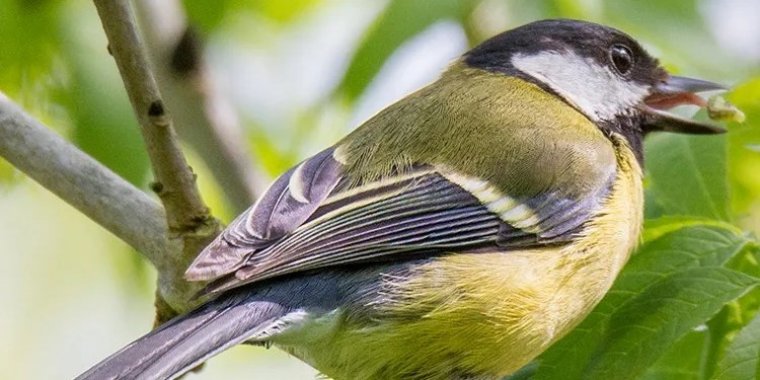| News / Science News |
Memory tests passed with flying colours
Blue and great tits recall what they have eaten in the past, where they found the food and when they found it, a new study shows. In the first experiment of its kind to involve wild animals, blue and great tits demonstrated ‘episodic-like’ memory to cope with changes in food availability when foraging.

Blue and great tits deploy surprisingly powerful memories to find food. Photo: University of Cambridge
Episodic memory is a memory system involving the conscious recollection of personally experienced events.
Many psychologists believe that episodic memory is uniquely human but a growing body of evidence suggests that many non-human animals possess episodic-like memory.
The study by researchers from the University of Cambridge and the University of East Anglia enabled 94 wild, free-living blue and great tits to take part in a series of memory tasks.
These tasks involved automated food containers and a new software program that created unique experiences for individual birds, and tracked each bird’s behaviour after they formed a memory.
The birds had previously been fitted with unique radio frequency tracking tags on their legs so that when they landed on the feeder’s special perch, this read their tag, and custom-built programs released (or did not release) food through an electronic door, according to experimental rules with unique timed events specific to each individual bird.
The experiment focused on blue tits and great tits partly because they are opportunistic foragers feeding on a wide range of food types, and may benefit from being able to recall ecological details from a single experience as this would permit flexible decision-making.
“These findings provide the first evidence for episodic-like memory in the wild and show that blue and great tits have a more flexible memory system than we used to assume,” said first author James Davies, from the University of Cambridge’s Comparative Cognition Lab.
“Previous studies on episodic-like memory have involved bigger-brained bird species, corvids, which hide food. This study focuses on smaller brained more generalist birds that don’t hide their food. Our findings suggest these birds are more intelligent than they’ve been given credit for.”
Senior author Dr Gabrielle Davidson from the University of East Anglia said: “The birds were behaving naturally in a familiar environment, so we captured something more realistic than if the birds had been captive. It was remarkable to see these birds performed well in our memory tasks while also experiencing a bunch of other memories out in the wild.
“For us, field research is challenging because the birds are completely free not to take part in our experiments and just fly away, but we’ve shown this type of intelligence test in the wild works.”
Nicola Clayton, Professor of Comparative Cognition at the University of Cambridge, an author of the study and James Davies’ PhD supervisor, said:
“It is fascinating that these non-caching species of birds showed episodic-like memory using two independent tests. When I began this research in the late 1990s, most psychologists assumed that the ability to remember the ‘what, where and when’ of unique past events was uniquely human.
“The initial findings in scrub-jays showed that this was not the case. Subsequent research suggests that this ability is much more widespread in the animal kingdom than we previously thought.”
The researchers suggest that having a more flexible memory could help these birds cope with further environmental stress and fluctuation influenced by climate change.
James Davies said: “This type of memory would allow them to flexibly react to new conditions and combine this information with their original memory to make decisions. So whether they’re thinking about fruit ripening or caterpillars emerging, that’s a powerful ability to have when things get tough.”
The study also might suggest that humans leaving out food for garden birds could be one factor contributing to the evolution of these memory traits, just as these birds have evolved beak adaptations in response to increased reliance on garden feeders.
Dr Gabrielle Davidson said: “It is possible that these birds are picking up on and remembering our routines in terms of when we top up bird feeders. This needs further study.”
To assess ‘what-where-when’ memory, the researchers adapted an existing study design – developed by Nicola Clayton and Anthony Dickinson – to simulate a realistic foraging scenario in which two food items – sunflower seeds and peanut pieces – ran out and replenished at different rates.
The foods were selected having already proven that great and blue tits prefer sunflower seeds to peanut pieces.
The birds were given time to learn the ‘temporal feeder’ rules before the tests began. When an individual was first detected on the ‘preferred’ sunflower seed feeder, this triggered a 2-hour period of availability to that bird.
After that point, a ‘replenish period’ began and the feeder door remained closed to that individual until the following day.
To pass the memory test, birds have to remember the details of this experience and apply it to new situations.
This means that when they come back to the feeders 2 hours later, they should remember they had already eaten their favourite food, and that only their less preferred food is currently available.
This research shows great tits and blue tits make this switch, without having to check if their favourite food is available.
This switch in behaviour, based on previous experience, is what indicates these birds use episodic-like memory - comparable to studies involving captive rodents, dogs, corvids, cephalopods and non-human primates.
In a different task, the researchers tested birds on their ability to recall ‘incidental details’ of feeders to locate food.
In a ‘where’ test, the feeders were arranged in a triangle and in a straight line. In the ‘which’ test, each feeder was painted a different colour (yellow, red or blue) or pattern (black stripes, wavy lines, or spots on a white background).
While most birds passed the ‘where’ test, in the ‘which’ test only the juveniles recalled visual clues to help them access food.
James Davies said: “We didn’t expect that finding. We already know juvenile blue tits and great tits have to be more innovative in their foraging because adults outcompete them and monopolise food, which may help to explain our own findings. As blue tits and great tits gain experience, perhaps they start to rely less on visual information and more on spatial information.”
YOU MAY ALSO LIKE





